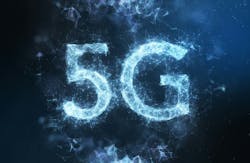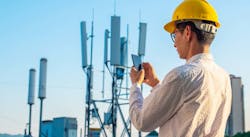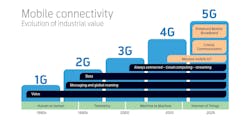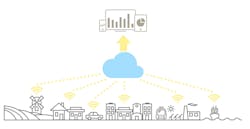The Road to 5G for IoT
Download this article in PDF format.
Over the coming years, 5G is set to fuel digital transformation globally, boosting industries and spurring innovation. As industry-leading enterprises steadily turn to next-generation networks and IoT, people’s lives, businesses, and society will improve significantly.
Now is the right time to prepare for what lies ahead. To stay ahead of the competition, enterprises need to understand the implications of 5G and the opportunities it will bring to those who are best positioned to embrace IoT.
Here we look beyond the hype and explore the reality of what 5G means for enterprises deploying connected solutions on mobile networks now and in the future.
Introduction
Digital transformation is fundamentally changing society, business, and the way we live our lives. Despite the rapid progress made in recent years, we are still in the early phases of a journey enabled through ubiquitous computing, storage, battery power, and networking.
Mobile networking is a key enabler of this transformation. Today, it provides global, reliable, and secure connectivity to more than 6 billion mobile broadband devices but also for almost 2 billion connected things by the end of 2022.
Until 2025, the number of cellular IoT subscribers is forecasted to grow at a compound annual growth rate (CAGR) of 16.6% to reach 3.74 billion at the end of the period. The IoT is playing a key role in digital transformation and, with 5G rapidly being deployed, IoT adoption will accelerate.
By connecting things enterprises can develop new or improve existing products, services, and business processes. From automotive to smart manufacturing and utilities, the role of IoT will grow in importance, transcending almost every industry.
In addition, IoT will continue to benefit society by enabling the implementation of government policy. For example, by enabling further control of electricity demand and fluctuating supply or minimizing waste of critical resources such as water.
Today’s mobile networks, known as 2G, 3G, and 4G, provide a strong foundation for connecting things. 2G, 3G, and 4G were originally developed to enable personal communication and mobile broadband services. Still, they have also proven extremely capable of the demands of IoT, offering technical capabilities exceeding most existing use cases and with characteristics particularly well-suited to IoT.
For example, global standardization and coverage mean products and services can be scaled globally. Building on the scale of the mobile industry and billions of connected mobiles enables cost efficiency, reliability, security, and continuous development of devices, network technologies, and service provider capabilities. At the same time, 5G is now rapidly being deployed across the globe.
With 5G, a mobile network generation has been designed for the first time from the ground up to support IoT use cases. 5G comes with dedicated capabilities tailored for various kinds of IoT applications, instead of having to adapt more general mobile communications that previous network generations resorted to. This will mean that entirely new IoT applications can be developed and continue to fuel the digital transformation journey, benefiting consumers, enterprises, and society.
In this white paper, we will explore the journey toward a 5 G-enabled digital transformation. This journey will take some years as 5G networks and capabilities are gradually made available, while in parallel earlier network generations are retired.
We will explore what we believe are the necessary steps for enterprises to take and offer insights on how enterprises should act to maximize the potential value of this new technology.
Mobile IoT Connectivity Enhancements From 5G
5G is the first mobile network that has been designed from the ground up to support IoT use cases. When 5G was designed a number of use cases were considered and the standard includes functionality to support a number of deployment scenarios, such as:
- Massive mobile IoT: Mass deployment for efficient and simpler IoT devices, for example, sensors. These devices often send little data but cost, energy efficiency, and reliable coverage can be critical for the use case to be relevant. 5G massive mobile IoT technology will enable low-cost devices with 10+ years of battery life and enhanced coverage even underground and in remote areas. Part of the technology to achieve this has been brought forward with 4G as NB-IoT and LTE-M and has in many countries been deployed before the 5G roll-out.
- Enhanced Mobile Broadband: 5G Enhanced brings more data. Today this is often used for data streaming. Enhanced Mobile Broadband is not only relevant for personal communication but also for IoT. Here the focus is on more data and throughput.
- Critical communication: 5G technology improves the predictability and security of data, providing a fast response that can be used in, for example, autonomous vehicles, or collaborative robots in Industry 4.0. Here the focus is on fast decision-making by devices, using fast and predictable service characteristics.
With 5G, IoT applications will also gain more control of the network characteristics and can program it to the needs of the use case.
For example, with LTE-M and NB-IoT there is network functionality that allows enhanced coverage or reduced battery consumption for an application. Over time it will be possible to take even more control over service levels, where data is processed etc.
Complementary technologies, such as network edge computing could take this even further, allowing the application to run in distributed cloud servers located close to the IoT device rather than in a centralized cloud data center.
The Road to 5G From an IoT Application Perspective
Over the last few years, 5G has been rapidly deployed in many markets across the world. At the same time, handsets capable of 5G have become increasingly affordable so that mobile broadband users can start to gain the benefits of 5G where available.
From an IoT application perspective, the situation is somewhat different. For example, continuous network access is required for many IoT use cases, meaning the application needs to optimize for networks with sufficient coverage. Application and device lifecycles are much longer than for consumer applications and handsets, so to avoid costly application redesigns or hardware replacements, architecture design and technology choices often need to be made with a 10-year horizon or more.
Device design constraints are different from the handset in other aspects as well, for example, cost and energy consumption requirements are often more stringent.
For IoT applications, it is therefore important to think ahead. The choices made today will impact the capabilities and cost of the connected solution for many years to come.
From an IoT application perspective, we think it is useful to think about the road to 5G in three phases:
- Phase 1 – Transition: Partial 5G coverage
- Phase 2 – Evolve: Sufficient 5G coverage
- Phase 3 – Transform: 5G ecosystem established
Phase 1 - Transition: Think Ahead!
The introduction of 5G is going to be over a 10+ year period. Each network generation is carefully standardized to ensure global interoperability.
The regulator in each country plans the use of the spectrum and awards licenses to use the spectrum. Communication service providers must secure spectrum licenses, conduct rollouts, and operate the new network. Rolling out a new national mobile network is a lengthy process, and it can take years before a new network generation achieves the same coverage as the network generations preceding it.
For IoT applications, this transition phase lasts until the new network technology provides sufficient coverage to remove dependency on legacy networks.
For international IoT applications, this phase lasts until all the countries that the application spans have sufficient coverage, and it is possible to access the needed network and functionality across borders in an efficient way. (As of December 2021, it should be noted that for some markets even the transition to 4G is still ongoing, with 2G or 3G still providing superior coverage).
For 5G, the coverage profile and roll-out time will vary considerably for different use cases. For example, massive mobile IoT capabilities like LTE-M and NB-IoT are optimized for wide-area coverage and have initiated rollouts already on top of existing 4G networks.
Another important consideration for IoT applications is the sunset of earlier mobile network generations. With the deployment of 4G and 5G networks, regulators and communication service providers across the globe are sunsetting 2G and 3G legacy networks to reuse valuable spectrum for new and more efficient technologies.
2G/3G sunsets are already in execution in markets like the USA and Australia.
For Europe, 2G sunsets are, in general, planned for the end of 2025. This is especially crucial for IoT applications that in many countries still rely on superior 2G coverage and with the long IoT device cycles, there are also still a substantial number of IoT devices that are 2G only and need to be upgraded to ensure continued operation.
During this phase, the IoT application needs to rely on multiple generations of networks to achieve sufficient coverage. This implies a cost in the device that needs more complex communication hardware than if single-mode hardware could be used. It also means the application cannot take full benefit of new network capabilities.
Below we have listed some practical considerations for enterprises designing or operating IoT applications during this phase.
Hardware to Grow With: The market is in very rapid development and using sufficiently future-proofed hardware you improve your chances of benefiting from future technical development. From a communication perspective, this often means using multi-mode hardware. For many IoT applications especially international ones, LTE-M is preferred over NB-IoT as it offers better support for software upgrades and international roaming.
Installed Base Review: After more than 30 years of commercial use, 2G or GSM (Global System for Mobile) is approaching end-of-life in many parts of the world. With the long IoT device life cycles, there are still considerable volumes of 2G-only devices in operation. The right strategy and execution plan are crucial to secure reliable performance in a cost-efficient transition.
Long-Term View: For new IoT applications and when hardware is upgraded, it's a good time to set and execute a longer-term technology and operating model strategy, e.g., is this the time to shift to a public cloud-based IoT platform-based application that will allow easier access to advanced 5G capabilities over time? For which part of the IoT application do you want to focus your digital expertise and which parts would you like to outsource?
5G and 4G will both be available for the foreseeable future. 2G has been in commercial operation for more than 30 years and 4G/5G is likely to operate for at least as long. 5G has been architected from its initial design to co-exist with 4G technology. For enterprises this means that both 5G and 4G will be available for a long time. Mobile IoT and Dynamic Spectrum Sharing are two examples of this co-existence.The Mobile IoT technologies LTE-M and NB-IoT were designed for 5G but rolled forward to work in 4G. LTE-M and NB-IoT were designed for efficiency for devices that use less data like sensors installed in buildings, and is suited for devices that have modest data requirements, but need a long battery life and comprehensive coverage.
Dynamic Spectrum Sharing enables Connectivity Service Providers to serve 4G and 5G devices in the same radio frequencies.Phase 2 - Evolve: Capture First 5G Benefits
As the 5G network coverage becomes sufficient it will become possible to start capturing the first benefits from the new capabilities. What coverage is needed depends on the needs of the application. For example, an application where the devices are moving and the communicated information is not time-critical requires less coverage than applications based on stationary devices or with near real-time characteristics.
The coverage also depends on which 5G technology is needed, e.g., low, and medium data applications relying on LTE-M and NB-IoT have been designed to provide enhanced coverage.
Depending on the location globally, typical IoT use cases will enter this phase sometime between now and 2025. For some, primarily national use cases and countries, this phase has already been reached.
The first 5G benefits that can be realized are closely related to physical connectivity. Once we can remove fallback technology and use 5G as the only technology, device cost can be reduced for applications with strict cost requirements, such as LTE-M or NB-IoT. This can also enable new applications that previously have not been economically feasible.
Download this article in PDF format.
New and enhanced applications can also be created leveraging other 5G characteristics, e.g., enhanced area and indoor coverage or very high data rates.
This is the beginning of the benefits of mobile IoT that will be realized from the 5G journey. To realize the next level of transformational benefits in an efficient way a 5G ecosystem needs to be formed with the tools and business models needed to reshape critical processes.
Some practical considerations for enterprises designing or operating IoT applications during this phase are listed below.
New Applications:
Lower device cost and battery consumption, more extensive coverage or higher data rates. As existing technical and economic limitations are relaxed, opportunities for innovating new applications or renovating existing ones may seem endless.
Focus digital competence on developing the business over resolving technical characteristics will be essential to winning.
Modern User Experience:
Consumers and business users today expect immediate responses from their applications. Many existing applications rely on 2G fallback and are designed based on the tools developed for personal communications. With 4G/5G devices, it is possible to bring an “always-on” user experience for IoT devices with human interaction like cars, alarm systems, and point-of-sales terminals.
Modern Architecture:
Through 5G technologies, it will be possible to simplify the architecture and set it up for further transformational change. In many cases, it will be possible to attach sensors directly to the mobile network improving TCO and operational characteristics compared to local mesh networks.
Building on managed IoT service deliveries to develop and operate the connected solution frees up digital resources for innovation while securing competitive cost levels and continuously benefitting from developing network, device, and cloud technologies.
Phase 3 - Transform: Reinvent Your Business Through the 5G Ecosystem
To enable the next level of digitalization and further enhance business and safety-critical processes, the IoT application must be able to ensure the right characteristics of the underlying network infrastructure. For example, data rates or response times may need to be assured, coverage maximized or where the data is processed needs to be controlled.
Through 5G the capabilities of the network can be exposed to the application which allows the application to program the network to support its specific needs. For this to work, the desired capabilities need to have been deployed in the network with sufficient coverage.
Achieving the full vision of 5G is complex and will take years but there are already emerging practical use cases and additional capabilities will become available step-by-step.
For example, in several national LTE-M/NB-IoT networks, it is now possible to access low power consumption and enhanced coverage capabilities from the network, paving the way for new use cases. International IoT service providers are integrating access to such functionality in their offerings making it increasingly relevant and feasible to deploy services relying on such functionality internationally.
For 5G capabilities to become accessible for the typical development project, these capabilities must also have been exposed by the surrounding ecosystem, e.g., integrated into the software and services used to build the application.
One early example of this is Telenor’s IoT Cloud service which includes functionality to support constrained devices based on exposure to the capabilities built into mobile networks. Telenor’s Managed IoT Cloud services enable the rapid development of connected solutions by providing the tools to collect, store, and analyze the data generated by connected devices.
Building on the mobile network security capabilities, offloading certificate handling from the device, and using constrained application protocols with the device, battery consumption, and processing requirements are reduced dramatically. At the same time, the developer can continue to use standard cloud-based tools and protocols (like MQTT or CoAP) ensuring efficient development and focus on business value.
Some practical considerations for enterprises designing or operating IoT applications during this phase are listed below.
- Step-by-Step Approach: The potential capabilities of the 5G network infrastructure currently being deployed globally are enormous. However, it will take time for the full capabilities to become available and for the 5G ecosystem to mature. Moving early comes at the cost of developing your own connectivity solutions and diverting precious digital competence from solving business challenges. For most enterprises, leveraging 5G capabilities as they step-by-step become available while maintaining a vision for future business transformation will be more attractive.
- Long-term Partners: 5G will cause a prolonged period of change in the mobile IoT connectivity ecosystem. Enterprises targeting to transform their business over time should choose partners that will deliver in the long run and who are credible in supporting business-critical processes.
- Business Focus: 5G and the associated technical capabilities such as mobile edge offer a technical toolbox on a completely different level than previous network generations. However, not all 5G capabilities are relevant for all use cases and most of these capabilities are best consumed as an integrated part of standard IoT platforms or managed services. Focusing on your business and building your IoT ecosystem will be even more important in the future.
The 5G Ecosystem - Working With the Right Partners
Today we are only in the first transition phase of 5G. Where should enterprises start?
5G will bring a lot of new capabilities. To benefit from these, enterprises need to ensure they work with partners that have the competency and stamina to invest over the coming five to ten years, as well as partners who have the right standing in the industry.
Telenor IoT is an industry-leading player in IoT. Together with technology and cloud partners, we enhance value for our customers. Our combined strength enables us to overcome the challenges enterprises face today, from device hardware, to connectivity options, and cloud worldwide. Get in touch to discuss your IoT solution requirements.







